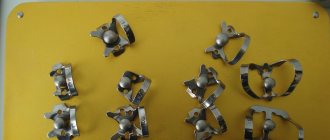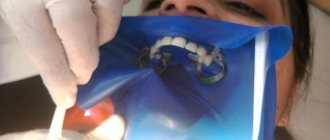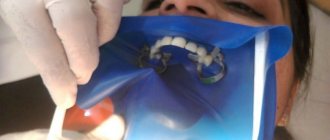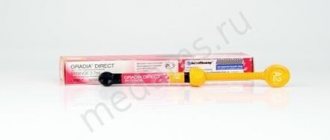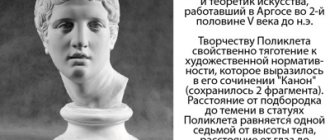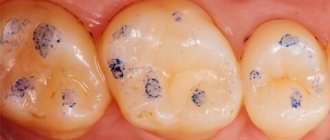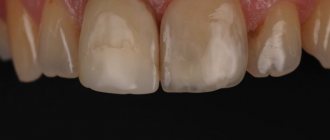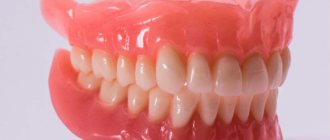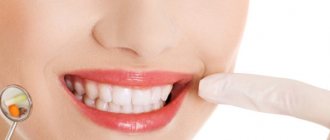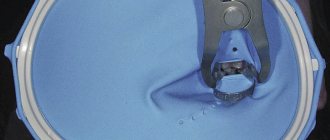FEATURES AND BENEFITS
- The easiest rubber dam system to learn and use.
- Guarantee of reliable isolation of the surgical field from various contaminants, which is the basis for the durability of the clinical result.
- Improved visibility and easier access to the oral cavity.
- Maximum comfort (less tension on the scarf and the ability to breathe through the nose) and reliable protection of the patient from aspiration or ingestion of foreign objects, as well as reducing the risk of infection.
- Less labor-intensive preparation for work compared to conventional rubber dam systems: cylindrical projections are easily cut off to form round holes (no need to mark teeth on a scarf using a template or punch holes with a punch).
- A simplified procedure for assembling and applying the rubber dam, which allows you to quickly fix it on the frame (in 3–5 seconds).
- Reducing tension and reducing the risk of clasps coming off thanks to the three-dimensional design of the rubber dam, the presence of two types of OptiDam ™ latex sheets (for the frontal and chewing groups of teeth) and the anatomical shape of the frame.
- Minimal risk of tearing due to the strength of the material.
- Ease of installation of the clasp and prevention of damage to tooth tissue and restorations.
- Fixation and protection of soft tissues of the oral cavity.
- Reduces the risk of an allergic reaction due to the low protein content and natural latex composition, as well as the absence of talc treatment.
- Possibility of reusable frames thanks to autoclaving (for 3 minutes at a temperature of 134 ° C).
- In case of accidental damage, the resulting hole is filled with liquid rubber dam (when using other systems, it is often necessary to use another scarf).
OptiDam - OptiDam - rubber dam
OptiDam is a rubber dam manufactured by Kerr.
This is an easy-to-use rubber dam that provides high-quality isolation of the working field.
An optimized Kerr rubber dam, its latex plate has a three-dimensional design with mastoid tubercles. This structure of latex allows you to do without the use of markings and punches.
Two types of latex plates have been developed to isolate any groups of teeth
OptiDam Posterior - for isolation of molars and premolars:
- No. 5200 - rubber dam for the chewing group of teeth (10 pcs + frame)
- No. 5201 — additional set of OptiDam Posterior refill, 30 rubber dams for the posterior group of teeth
- No. 5205 — Large additional set of OptiDam Posterior Bulk refill, 60 rubber dams for the posterior group of teeth
OptiDam Anterior - for isolating the frontal group of teeth:
- No. 5203 - rubber dam for front teeth (10 pcs + frame)
- No. 5204 - additional set of OptiDam Anterior refill, 30 rubber dams for anterior teeth (30 pcs)
- No. 5206 — Large additional set of OptiDam Аnterior Bulk refill, 60 rubber dams for anterior teeth (60 pcs)
3D design and anatomical frame conform to the shape of the mouth
- Reduced tension makes the rubber dam easy to assemble and can be placed immediately in the mouth
- No need to trim excess material
- Expands available oral area and improves visibility for optimal working conditions
- Increased patient comfort
Cylindrical lug design reduces prep work
- No labor-intensive marking of teeth on the rubber dam is required
- Thanks to the cylindrical shaped and outwardly shaped protrusions, no punching is required as the protrusions are easily sheared off to create perfectly round holes
Makes the dentist's work quick and efficient
- Thanks to the use of OptiDam, the operating field remains dry and clean, which ensures the safety of dental procedures.
- OptiDam isolates all soft tissue, providing unrivaled ease of access: there is no longer the need to immobilize the patient's tongue. In addition, the patient’s cheeks, lips and gums will no longer interfere with your work
- OptiDam guarantees reliable isolation of the surgical field from various contaminants, which is the basis for the durability of the clinical result: materials that are sensitive to moisture can be used. The working field is kept perfectly dry
- OptiDam provides reliable protection for both the patient and the medical staff: Your patients are protected from aspiration and ingestion of foreign objects. The amount of dust entering the patient’s body with air during work is reduced. For you and your staff, OptiDam reduces the risk of infection from patient saliva and blood.
Technical characteristics of OptiDam
Cofferdam
- Natural latex composition of high quality
- One size fits all
- No smell
Frame
- Anatomical shape
- Reusable medical thermoplastic material
- Autoclavable for 3 minutes at 134C
The rubber dam was invented in 1883 by the French physician La Roche. Russian dentists have always widely used means to isolate the surgical field (Fig. 1). Here is what A. B. Izachik writes about the rubber dam in his manual for dentists and students, “Dentiatry,” published in 1915: “The best means for isolating a tooth from the action of saliva is a rubber dam.” Despite the fact that the rubber dam of Dr. Izachik’s time was a very cumbersome structure (Fig. 2), it was widely used. In modern dental practice, few doctors use rubber dams. As a reason for refusing a rubber dam, many dentists cite the time required for its application and removal, the complexity of the application procedure, but JKJingle, a famous German doctor, responded to this argument as follows: “The greatest loss of time when using a rubber dam is to convince colleagues in its advantages and reliability.” It is the desire for optimal, safe dental treatment that is the basis for the use of rubber dams in dental practice.
In some cases, applying a rubber dam does present certain difficulties, but once you start working with it, it is impossible to abandon it. It becomes as necessary as gloves, a mask and a protective shield (Fig. 3).
Having experience with a traditional rubber dam system, it is difficult to imagine that it can be improved or something new can be invented. However, Kerr has developed a rubber dam that combines unsurpassed comfort and ease of handling, making it much easier to handle and reducing the time spent on its application.
| Rice. 2. Rubber dam applied (from the book by A.B. Izachik) | ||
| Rice. 1. Molar isolation (from the book by A.B. Izachik) | Rice. 3. Rubber dam is a necessary means of protection | Rice. 4. Optidam |
| Rice. 5. OptiDam 3D latex design | Rice. 6. Cutting off the tubercles with scissors | Rice. 7. Inserting latex into the interdental space using floss |
Two types of latex plates have been developed for isolating any groups of teeth - OptiDam Anterior - for isolating canines and incisors, OptiDam Posterior - for isolating molars and premolars. The combination of the three-dimensional design of the latex and frame with an anatomical design provides the following advantages: reduces latex tension and pressure on the clamps, does not restrict the patient's breathing, provides the doctor with an excellent view and does not interfere with access to the necessary area.
To apply OptiDam, the 3D rubber dam must be secured to the frame, the corresponding mastoid tubercles must be cut off, a wing clamp must be inserted into the hole, and the OptiDam is ready for fixation in the oral cavity. However, before applying a rubber dam, it is necessary to check the patency of the interdental spaces. Floss is traditionally used to facilitate the insertion of latex between teeth (Fig. 7). Latex is well fixed without clamps (Fig. 8), however, if additional fixation is necessary (Fig. 9) or highlighting the cervical area of the tooth, traditional clamps can be used (Fig. 10). OptiDam is applied highlighting the frontal teeth (Fig. 11).
OptiDam Posterior (Fig. 12) is very convenient for isolating teeth during endodontic treatment. The absence of latex tension facilitates all stages of treatment and obturation of root canals (Fig. 13 - 16).
While working with OptiDam we noted:
- The patient's nose is not blocked and can breathe freely.
- Anatomical frame design provides stronger latex retention and easy access for fluid evacuation
- Latex tightly fits the teeth, neither saliva nor gingival fluid penetrates into the surgical field, it remains perfectly dry.
- Latex moves the tongue, cheeks and lips well, they do not interfere with work.
Thus, OptiDam provides reliable protection for both the patient and medical personnel. The patient is protected from aspiration or ingestion of foreign objects. The amount of dust entering the patient’s respiratory tract with air during work is reduced. For the doctor and his assistant, the risk of infection due to contact with the patient’s saliva and blood on the skin is reduced.
The OptiDam™ is definitely an interesting and convenient model that is worth trying. (Fig. 17).
| Rice. 8. Frontal teeth are isolated |
| Rice. 9. Additional fixation of three-dimensional latex with traditional clamps |
| Rice. 10. Isolation of the cervical area of the incisor with a butterfly clamp |
| Rice. 11. OptiDam Anterior applied! |
| Rice. 12. OptiDam Posterior |
| Rice. 13. Isolation of the 37th tooth for endodontic treatment |
| Rice. 14. Flushing the canal with sodium hypochlorite |
| Rice. 15. Lateral condensation |
| Rice. 16. The canal is obstructed |
| Rice. 17. Optimal rubber dam |
The combination of 3D latex and frame design with anatomical design provides the following benefits:
- reduces latex tension and pressure on valves,
- does not restrict the patient's breathing,
- provides the doctor with an excellent overview and does not interfere with access to the required area.
APPLICATION OF OPTIDAM ON CHEWING TEETH
- Run dental floss between the teeth to identify potential problems when installing the dental dam.
- Determine the color of the teeth if aesthetic restoration is intended.
- Determine the teeth on which the rubber dam will be installed. During endodontic treatment, it is recommended to install the SoftClamp on the posterior tooth.
- Place the rubber dam onto the frame.
- Cut off the cylindrical projections on the OptiDam corresponding to the teeth on which the rubber dam will be installed, leaving 1 mm to invert the scarf into the sulcus.
- Insert the SoftClamp clasp into the last hole made.
- Secure the rubber dam using SoftClamp to the tooth next to the tooth to be restored. If the tooth being restored is the last one in the dentition, then the SoftClamp is installed on it.
- Guide the dental dam through the interdental contact using waxed FixaFloss. To facilitate the passage of the rubber dam through the interdental contact, use a lubricant if necessary.
OptiDam Posterior set (frame + 10 sheets) No. 5200 | KERR (USA)
OptiDam Posterior Intro Kit (OptiDam) - a set of ten rubber dams and a frame of the OptiDam system. Designed for use on chewing teeth.
OptiDam is the easiest rubber dam system to learn and use. Allows you to quickly and reliably isolate the working field, while ensuring comfort for both the doctor and the patient. The system does not require complex preparation and assembly. The sheets have an anatomical convex shape and protrusions in the places where the teeth are supposed to be located. The projections are cylindrical in shape and can be easily cut to form round holes. OptiDam sheets are made from durable natural latex.
Set contents: 10 rubber dams for chewing teeth + frame.
- Indications
- Advantages
- Instructions for use
- Storage
Indications
- During endodontic treatment.
- When performing direct restorations.
- When sealing fissures.
- During the whitening procedure.
Advantages
- The easiest rubber dam system to learn and use.
- Guaranteeing reliable isolation of the surgical field from various contaminants is the basis for the durability of the clinical result.
- Improved visibility and easier access to the oral cavity.
- Maximum comfort (less tension on the scarf and the ability to breathe through the nose) and reliable protection of the patient from aspiration or ingestion of foreign objects, as well as reducing the risk of infection.
- Less labor-intensive preparation for work compared to conventional rubber dam systems: cylindrical projections are easily cut off to form round holes (no need to mark teeth on a scarf using a template or punch holes with a punch).
- A simplified procedure for assembling and applying the rubber dam, which allows you to quickly fix it on the frame (in 3–5 seconds).
- Reducing tension and reducing the risk of clasps coming off thanks to the three-dimensional design of the rubber dam, the presence of two types of OptiDam latex sheets (for the frontal and chewing groups of teeth) and the anatomical shape of the frame.
- Minimal risk of tearing due to the strength of the material.
- Ease of installation of the clasp and prevention of damage to tooth tissue and restorations.
- Fixation and protection of soft tissues of the oral cavity.
- Low protein content, natural latex and no talc treatment to reduce the risk of an allergic reaction.
- Possibility of reusable frames thanks to autoclaving (for 3 minutes at a temperature of 134 ° C).
- In case of accidental damage, the resulting hole is filled with liquid rubber dam (when using other systems, it is often necessary to use another scarf).
Instructions for use
Do not use in patients with latex allergies.
- Run dental floss between the teeth to identify potential problems when installing the dental dam.
- Determine the color of the teeth if aesthetic restoration is intended.
- Determine the teeth on which the rubber dam will be installed. During endodontic treatment, it is recommended to install the SoftClamp on the posterior tooth.
- Place the rubber dam onto the frame.
- Cut off the cylindrical projections on the OptiDam corresponding to the teeth on which the rubber dam will be installed, leaving 1 mm to invert the scarf into the sulcus.
- Insert the SoftClamp clasp into the last hole made.
- Secure the rubber dam using SoftClamp to the tooth next to the tooth to be restored. If the tooth being restored is the last one in the dentition, then the SoftClamp is installed on it.
- Guide the dental dam through the interdental contact using waxed FixaFloss. To facilitate the passage of the rubber dam through the interdental contact, use a lubricant if necessary.
Specifications
- Purpose: Dentistry. Isolation of the working field during therapeutic and treatment-and-prophylactic procedures.
- Set contents: 10 rubber dams for chewing teeth + frame
- Material: Low protein latex. No powdering.
Storage
Keep out of the reach of children. For dental use only.
Kerr (KaVo Kerr) is a developer and manufacturer of dental materials. The company was founded in 1891 in the USA. Today Kerr (KaVo Kerr) is one of the leading manufacturers and industry standard setter. The Kerr name is synonymous with excellence for dental professionals around the world.
